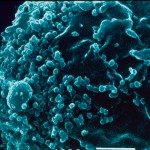Lien vers Pubmed [PMID] – 25281758
J. Infect. Dis. 2015 Mar;211(5):769-79
BACKGROUND: Conventional regulatory T cells (Tregs) can suppress human immunodeficiency virus type 1 (HIV-1)-specific immune responses but cannot control immune activation in primary HIV infection. Here, we characterized Treg subsets, using recently defined phenotypic delineation, and analyzed the relative contribution of cell subsets to the production of immunosuppressive cytokines in primary HIV infection.
METHODS: In a longitudinal prospective study, ex vivo phenotyping of fresh peripheral blood mononuclear cells from patients with primary HIV infection was performed at baseline and month 6 of follow-up to characterize Treg subsets, immune activation, and cytokine production in isolated CD4(+) T cells.
RESULTS: The frequency of CD4(+)CD25(+)CD127(low) Tregs and the distribution between the naive, memory, and activated/memory Treg subsets was similar in patients and healthy donors. However, Tregs from patients with primary HIV infection showed peculiar phenotypic profiles, such as elevated FoxP3, ICOS, and CTLA-4 expression, with CTLA-4 expression strikingly increased in all Treg subsets both at baseline and month 6 of follow-up. The great majority of interleukin 10 (IL-10)-producing CD4(+) T cells were FoxP3(neg) (ie, Tr1-like cells). In contrast to conventional Tregs, Tr1-like cells were inversely correlated with immune activation and not associated with lower effector T-cell responses.
CONCLUSION: FoxP3(neg) Tr1-like cells-major contributors to IL-10 production-may have a beneficial role by controlling immune activation in early HIV infection.




